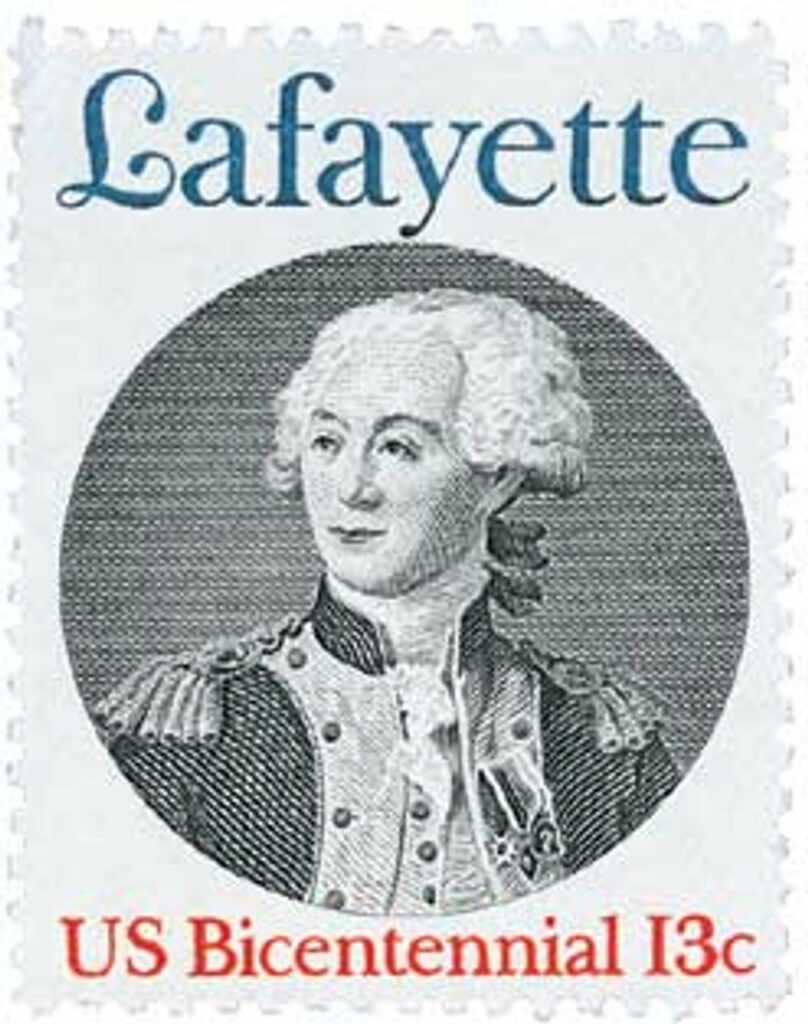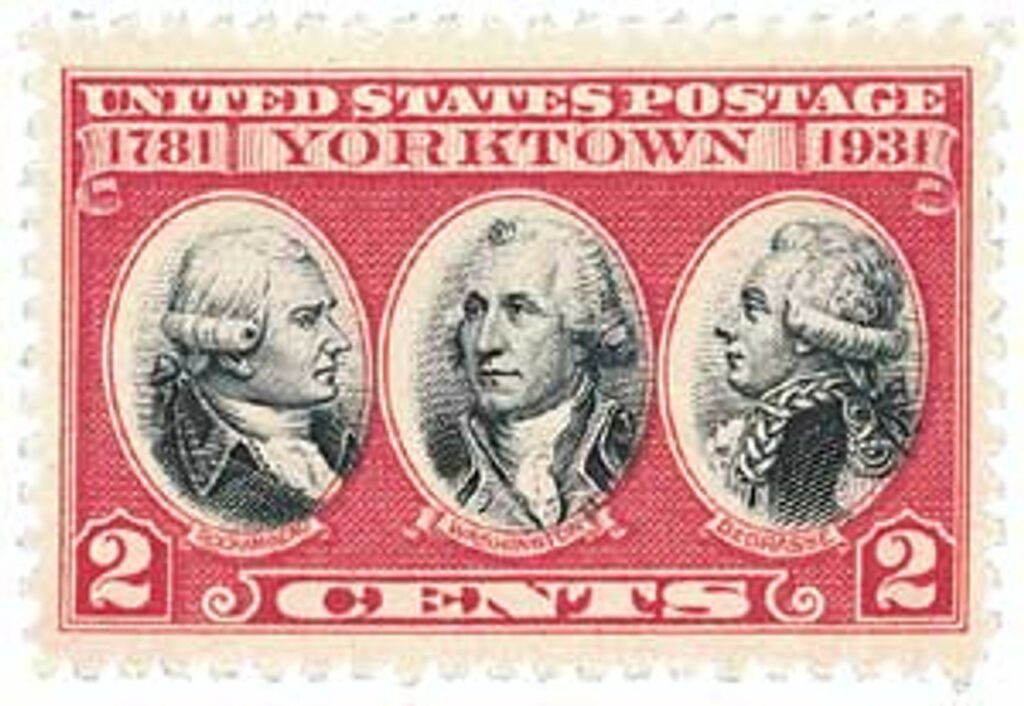
On September 6, 1757, Marie-Joseph Paul Yves Roch Gilbert du Motier de Lafayette, better known as the Marquis de Lafayette was born in Chavaniac, in Haute Loire, France, to a wealthy family. With ancestors who’d fought alongside Joan of Arc, Lafayette developed an early hunger for military glory.
His father died on the battlefield when Lafayette was two years old. His mother and grandmother died when he was 13. The young orphan inherited a great fortune. Descended from a long line of soldiers, Lafayette studied at the Military Academy at Versailles. When he was 16, he married Marie Adrienne Françoise de Noailles, the daughter of one of the most powerful families in France. Shortly after his marriage, Lafayette became a captain in the cavalry. However, he disliked court life, and soon grew interested in the events of the American Revolution.
Serving in the French military, he traveled to Metz for duty, and by chance, attended a dinner with the duke of Gloucester, the younger brother of King George III. As the duke complained about the American colonists and mocked their revolutionary beliefs, Lafayette realized his mission. As he later recalled, “My heart was enlisted… and I thought only of joining my colors to those of the revolutionaries.”

Against the orders of his king, Louis XVI, Lafayette bought his own ship, convinced several French officers to accompany him, and sailed for America. On June 13, 1777, he arrived near Charleston, South Carolina, and volunteered his services to the war effort.

At first, the Continental Congress was unimpressed with Lafayette, who spoke little English. They’d received offers from countless other Frenchmen seeking glory. But, when he agreed to serve without pay, the cash-poor Continental Congress appointed him a major general. He ended up paying over $200,000 of his own money during the war for his staff’s salaries, uniforms, and other expenses.
Ben Franklin reportedly urged George Washington to take the 19-year-old Lafayette under his wing. The two men met on August 10, 1777. Lafayette humbly explained he was there to learn, not to teach, which impressed Washington, and the two quickly grew close. In fact, after Lafayette was shot in the leg during the battle at Brandywine Creek, Washington summoned his personal surgeon and told him to treat Lafayette as if he were his son. Impressed with Lafayette’s courage, Washington recommended him for divisional command, which he received.
Lafayette’s victory at Gloucester earned him the command of a division. He served at Valley Forge during part of the terrible winter of 1777-78. Lafayette also fought at the battles of Barren Hill and Monmouth, and during the campaign to capture Rhode Island.
In 1779, Lafayette returned to France to smooth out relations and get the support of the French fleet. Though he received a hero’s welcome, he was briefly imprisoned for defying King Louis XVI. Lafayette then returned to America to aid in the American victory at Yorktown. When he returned to France in 1782, Lafayette was received as a “hero to two worlds.”
Lafayette and Washington remained close, despite the ocean between them. They wrote each other regularly and Lafayette even sent Washington the key to Bastille after he led the attack there. When Lafayette died on May 20, 1834, America went into mourning, and Congress requested that citizens wear black for a month to honor his memory.
| FREE printable This Day in History album pages Download a PDF of today’s article. Get a binder or other supplies to create your This Day in History album. |
Discover what else happened on This Day in History.




A brave man. We owe our freedom to many such men.
Very interesting.Great information.
Sad to say, I understand that Common Core doesn’t teach U.S history prior to 1880.
In our District we teach American History from pre-history to the post Civil War reconstruction period (approx 1875) in 8th grade and U.S. History from 1875 to present day. So, yes High School
Common Core starts about 1875.
Thank you, Kenneth. As a regular reader of these posts I see a lot of people commenting on education, or the lack of it, in today’s schools. And I can’t help but wonder where these folks are getting their information. Thanks for providing some direct information on what’s really happening today.
Great information. Juste some addition to the story. La Fayette returned in 1780 aboard the frigate Hermione, When he was participating at the battle of Yorktown, the frigate with the other warships participated at the blocade of the Chesapeake. After its return to France the frigate shank in 1793. After a 20 years effort, a replica was built and in 2015 the replica sailed to America. During this month long sailing the frigate visited many port along the east coast, in each port various ceremonies took place. L’Hermione will be forever associated with La Fayette.
Excellent comment but let’s correct it to sank.
Does anyone know what happened to the key?
The last time I visited Mt. Vernon, the key was hanging in a glass case on the wall of the vestibule.
K Ryan
I visited Mt. Vernon last week and the key was still there!
It is a wonder how someone of such affluence from a foreign country could take such a passionate interest in the cause of an upstart, fledgling country which was primarily known as the 13 colonies. He is honored in major cities and states of our nation including my own with a street in his honor along with Lafayette square, an opera type movie theater, a county and on and on. Of course we ( the U.S.A.) return the favor daily with our troops in fledgling nations.
Because of Lafayette France became America’s oldest friend and ally since the American Revolution. France even awarded the Statue of Liberty on America’s one hundredth birthday. Our government needs to listen to France more often and follow her advice; for these reasons, we could have avoided getting involved in the Vietnam war and the invasion of Iraq in 2003. Lafayette was truly a great man and a hero on both sides of the great pond!
The return of Lafayette in the 1820s and tour of the then existing America, his being welcomed nationwide as a hero, his visit to Upstate New York and exclaiming: “Where are my Oneida friends?” (They had been booted West with the other Native Americans) is worth mentioning.
That was a long war against the Britts. Juan Nepomuceno Seguin had a similar story, fighting for both countries, first as a texan and later on against them and eventually considered a traitor and died forgotten in Mexico. Ignacio Zaragoza Seguin, no relationship and different eras, born in now Goliad, Texas republic, fought against the French as a mexican general in Puebla and died young at 33 of typhoid fever, before the antibiotics existed. It is one of the greatest heroes forever in Mexico.